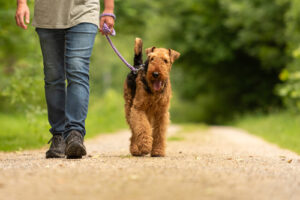One of the great joys of having a canine companion is sharing your outings with them! Dogs love to be included, and having your dog along may open your eyes to things you may have otherwise overlooked.
Many dogs can accompany their family off leash, but some cannot be trusted to stay close or mind their manners without that connection. All dogs need to know how to walk politely on a leash for those times when a loose dog is inappropriate.
Leash behavior training is easiest when started with the puppy. Initially, puppies need to just get used to the feeling of a collar and leash, much the same as a child with a new set of braces! Puppies will scratch at the collar, and chew at the leash. Distraction with positive attention or a favorite toy can help ease this transition. When you first start carrying the leash, try not to pull the puppy. Keep the leash loose and call the puppy to you to keep them moving.
As the puppy grows, the next phase includes pulling behavior. From their perspective, pulling gets a dog to the place it wants to be. Dogs learn by doing what works for them; if pulling moves things along, they will continue to do it. If every time the dog pulls, the handler stops walking, a young dog will learn that pulling never gets them where they want to go.
That said, some dogs are more challenging than others. Head collars (such as Gentle Leader or Promise Collar) can be a very successful mode of control without using punishment. Having the control point out in front (under the nose) means that it is harder for them to look forward while pulling, and they will naturally back off.
Other common leash problems are lunging and barking. These can be play behaviors, territoriality, or aggression. It is best to address these issues quickly, and there are many professionals to help, such as veterinarians or trainers. While an owner is working with a problem behavior, it is especially difficult if others approach the dog.
There is a movement to create a universal symbol to let others know not to approach a leashed dog. It is called the Yellow Dog Project, and the symbol is a yellow ribbon tied to the leash. To learn more, visit the website: www.yellowdogproject.com.
Julie C. Keene MS, DVM, Ph.D.




